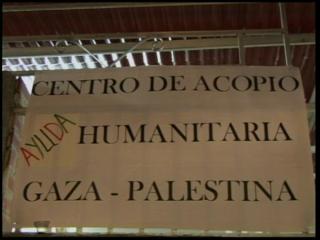JERUSALEM – Human Rights Watch said Sunday that Israel's military has fired artillery shells with the incendiary agent white phosphorus into Gaza and a doctor there said the chemical was suspected in the case of 10 burn victims who had skin peeling off their faces and bodies.
Researchers in Israel from the rights group witnessed hours of artillery bombardments that sent trails of burning smoke indicating white phosphorus over the Jebaliya refugee camp in northern Gaza. But they could not confirm injuries on the ground because they have been barred from entering the territory.
The chief doctor at Nasser Hospital in southern Gaza said he treated several victims there with serious burns that might have been caused by phosphorus. He said, however, that he did not have the resources or expertise to say with certainty what caused the injuries.
The substance can cause serious burns if it touches the skin and can spark fires on the ground, the rights group said in a written statement calling on Israel not to use it in crowded areas of Gaza.
Military spokeswoman Maj. Avital Leibovich refused to comment directly on whether Israel was using phosphorus, but said the army was "using its munitions in accordance with international law."
Israel used white phosphorus in its 34-day war with Hezbollah in Lebanon in 2006. The U.S. military in Iraq used the incendiary during a November 2004 operation against insurgents in the city of Fallujah.
An AP photographer and a TV crew based in Gaza visited Nasser Hospital in Khan Younis on Sunday and recorded images of several burn patients.
One of them, Haitham Tahseen, recalled sitting outside his home with his family in the morning when something exploded above them.
"Suddenly, I saw bombs coming with white smoke," said the man, whose burned face was covered with medical cream. "It looked very red and it had white smoke. That's the first time I've seen such a thing."
His cousin, in another hospital bed, was more severely burned, with patches of skin peeling off his face and body, and had to be wrapped with thick white bandages.
The hospital's chief doctor, Youssef Abu Rish, said the burns were not from contact with fire, but he couldn't say what sort of substance caused them. He said information he collected on the Internet indicated it could have been white phosphorus.
White phosphorus is not considered a chemical weapon, and militaries are permitted under laws of warfare to use it in artillery shells, bombs and rockets to create smoke screens to hide troop movements as well as bright bursts in the air to illuminate battlefields at night.
Israel is not party to a convention regulating its use. Under customary laws of war, however, Israel would be expected to take all feasible precautions to minimize the impact of white phosphorus on civilians, Human Rights Watch said.
"What we're saying is the use of white phosphorus in densely populated areas like a refugee camp is showing that the Israelis are not taking all feasible precautions," said Marc Garlasco, a senior military analyst for the rights group. "It's just an unnecessary risk to the civilian population, not only in the potential for wounds but also for burning homes and infrastructure."
Garlasco was among researchers on a ridge about a mile (1.5 kilometers) from the Gaza border who observed the shelling from a 155mm artillery unit on Friday and Saturday.
Some of the burning trails of smoke caused fires on the ground that appeared to go out after a few minutes, said Garlasco, who formerly worked at the Pentagon where he was in charge of recommending high-value targets for airstrikes during the 2003 invasion of Iraq.
Each 155mm shell contains 116 of what Garlasco described as wafers doused in phosphorus that can be spread over an area as large as a sports field, depending on the height at which it detonates. The phosphorus ignites when it comes in contact with oxygen.
Human Rights Watch has not been able to confirm whether there have been any civilian casualties from phosphorus. The group has a consultant working for it inside Gaza but he has been unable to move around due to the danger. Foreign journalists have also been barred from entering Gaza.
Garlasco said photos published Thursday in British newspaper The Times showed Israeli units handling American-manufactured white phosphorus shells with fuses on them.



No comments:
Post a Comment